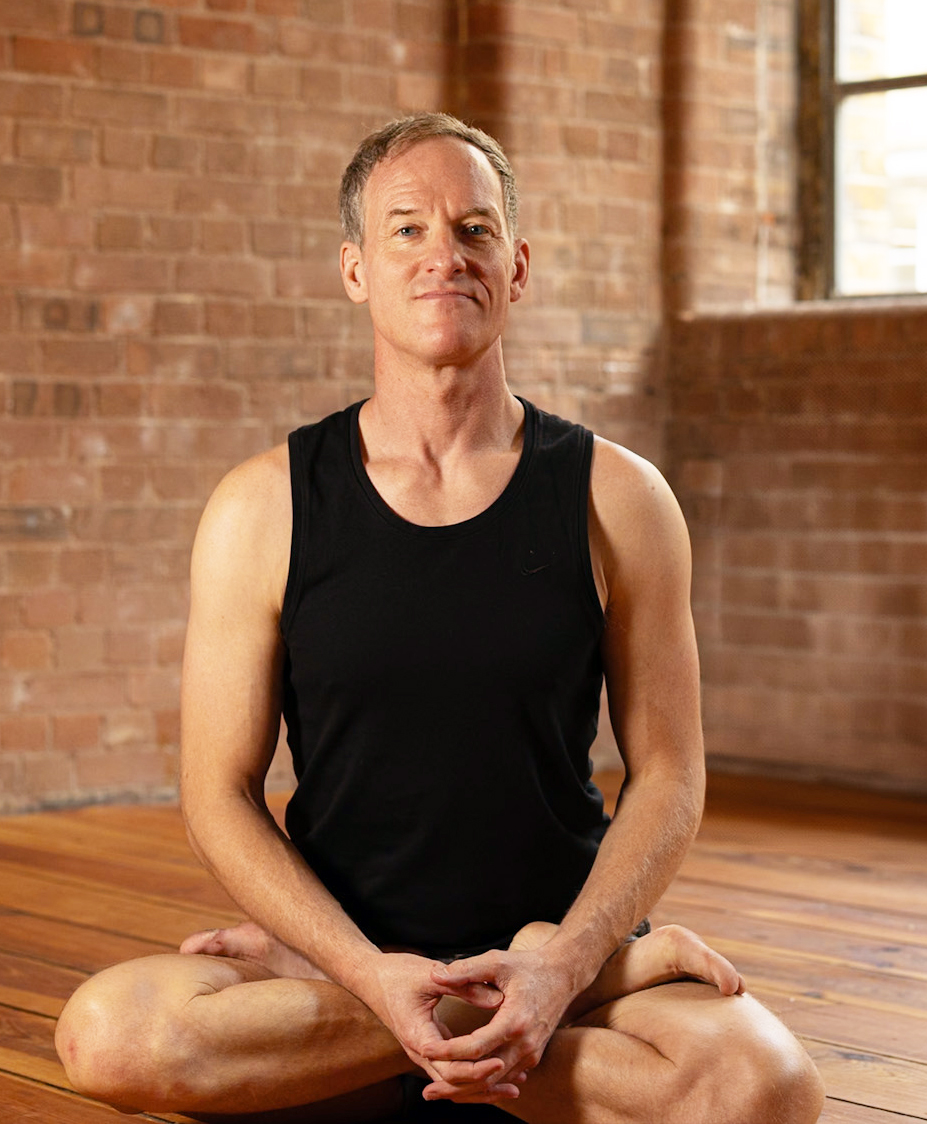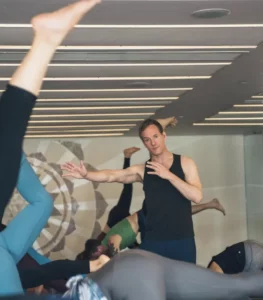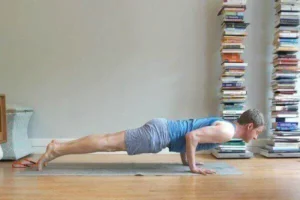So, you’re thinking about yoga teacher training, but you have questions — lots of questions. You’ve landed in the right spot! I’ve been leading teacher trainings — both in-person and online — for more than two decades and I’ve put this guide together to help you navigate this exciting and potentially overwhelming life choice!
First up — the question I get asked most often:
Am I ready for yoga teacher training?
Honestly, only you can answer that question.
But if you’ve made it this far in your search, then you’re clearly motivated to learn more about yoga!
Your passion and interest in the subject is key.
And while I can’t say for certain whether or not you’re ready for a teacher training, I am very familiar with the ways people typically self-sabotage and get in their own way when thinking about teacher training.
I’m here to help you get over those self-imposed hurdles!
Myths & Self-Sabotage
Myth #1: My practice isn't "advanced enough" for YTT. I'm not bendy/strong/young/fill-in-the-blank.
The truth: If you’re stuck in the narrative of not being “enough,” | implore you to let that go. In all of my trainings, there’s a huge range of skill and ability, there’s a wide age range, and there are people from all walks of life and professions.
All are welcome. Truly. I aim to create a very supportive learning environment.
You don’t have to be able to do a Handstand. And I don’t care if you can press into an arm balance or not. I care if you are a sincere student. That’s it! You are enough, just as you are.
Myth #2: I have a busy life. I'm just not sure that I'll have time for a training.
The truth: As I’ve gotten older, it’s become clear to me that I make time for the things I really want to do. Of course, there are exceptions to this rule, but, in general, when we really want to do something, we’re excited about it and we’re able to shift things around to make it work.
If now is the right time and you really feel yourself pulled toward a yoga teacher training, you will figure it out.
If time is tight for you, consider an online teacher training because you do the bulk of the learning on your own schedule. You can also rewind and rewatch videos and practices.
Myth #3: I'm an introvert and I'm afraid to speak in front a group. Can I really teach yoga?
A whopping 75% of people are afraid of public speaking – so if you’re in this group, you’re not alone.
The art of teaching does take practice. But it’s best to think of it as a skill that can be learned – and a good teacher training will break down this skill step-by-step, giving you plenty of practice so that you can learn it.
I’m also an introvert, but teaching yoga is different than the feeling of having to give a toast at a wedding or make small talk at a party. When I’m teaching, I’m sharing knowledge and guidance about something I care about.
OK, but I might not want to teach -- should I really do a 200-Hour Yoga Teacher Training?
A lot of people do 200-hour yoga teacher trainings without planning to teach. The truth is, there is no better way to deepen your practice than to immerse yourself in a high-quality 200-hour.
By now you probably know that drop-in yoga classes simply don’t give you enough time to absorb and integrate the practice and it’s impossible to get the full picture.
A high-quality 200-hour training will help you create the foundation for a lasting personal practice. It will introduce you to the subtle aspects of yoga – not just as movement, but as a path toward quietness and self-inquiry. You will learn to regulate your nervous system with simple, powerful tools.
Yoga teacher training isn’t just about becoming a teacher-it’s about becoming more yourself. It stretches you in new ways and opens doors you didn’t know were there.
That’s my long-winded way of saying a resounding — yes! It’s worth investing your time, energy, and financial resources even if you’re not sure you’ll teach.
And if you’d like more reassurance that yoga teacher training is transformative, I go into more detail about this in my webinar, “7 Ways Yoga Teacher Training Can Transform Your Life,” which you can watch here.
What are the components of a 200-Hour Yoga Teacher Training?
All Yoga Alliance accredited 200-hour trainings require hours in 4 core areas:
- Techniques, Training & Practice
- Anatomy & Physiology
- Yoga Humanities
- Professional Essentials
In my 200-hour YTT, you get a well-rounded education across every pillar of yoga. Here’s an abbreviated overview (for a full syllabus, click here):
Principles of Asana & The Yoga Tradition Deep Dives into the Poses of Each Postural Family
- Standing Postures
- Sun Salutations
- Backbends
- Seated Forward Bends
- Twists & Sidebends
- Arm Balances
- Inversions
Yoga Anatomy
- Why We Learn Anatomy
- Best Practices & Pitfalls
- Key Terminology
- Spine & Core
- The Breath
- Feet, Legs, Knees, & Hips
- Shoulders, Neck, & Upper Back
- Active/Passive RoM and End Range Strength
The Fundamentals of Sequencing & Curriculum
- Sequencing Principles
- Classic Frameworks
- Peak Pose Sequencing
- The Master
- Sequencing Template
- Well Balanced Sequencing
- Sequencing for Each Pose Category
- Keys to Exceptional Verbal Cueing
Yoga History & Philosophy
- Fundamentals of Yoga Philosophy
- Patanjali’s Yoga Sutra
- Sankhya, Purusha, Prakriti
- The Gunas and Citta
- Yoga History & Philsophy (continued):
- The Kleshas and the Vrittis
- Timeline of Yoga
- Essence of Hatha Yoga
- The Subtle Body
- Bandhas, Mudra, and Mantra
- The Business of Yoga:
- How Compensation Works
- Operating an Independent Business
- Finding Teaching Jobs
- Nailing Your Teacher Audition
- Developing a Student Base
- Consistency, Reliability and Progression
- Marketing and Social Media
- Teaching Yoga Online
Meditation, Pranayama, and Restorative Practices
- Yoga Nidra
- Introduction to Mindfulness Meditation
- Mindfulness of the Body
- Mindfulness of Feeling Tone
- Mindfulness of Thoughts
- Concentration Meditation
- Lovingkindness Meditation
- Kapalabhati, Viloma, Ujaayi, Bhedana, Nadi Shodana Pranayama
What should I look for in a yoga teacher training?
Rapport, resonance, the “right fit.” If you already have a teacher or a community you resonate with, start there. If you’re unsure of who to train with, consider it an opportunity sample other teachers – take online classes, listen to podcasts, watch yoga teachers on YouTube teachers – and see which teacher and approach feels like the right fit for you.
Experience
Teacher training is transformative and can make people feel raw, vulnerable, and exposed. An experienced teacher will establish a safe learning environment and will be able to “see” their individual students – not just how their bodies move, but how they’re responding to the instructions and the dynamics of the group.
An experienced teacher will have also worked out their own communication glitches, so that they can transmit the teachings in a way that’s authentic to them and relevant to you! I know from my own experience that it’s taken me years of practice to be able to communicate the vastness of this subject matter and I’m still always learning.
Multi-sensory Learning and Clear Organization
Look for thoughtful organization and design. My training combines in-depth video content, structured group learning, and direct support and feedback from me. You’re not just watching – you’re practicing, reflecting, and growing.
What's better -- in-person or online yoga teacher training?
In-person training is great if:
- You already have a strong studio or community you love.
- You want to travel (e.g., to Bali or Costa Rica).
Otherwise, for every other possible reason, online is better. Here’s why:
- Online trainings are infinitely more convenient. It’s really difficult to put aside 15 weekends in a row or put your life on hold to go to Bali for a month.
- When you add in travel costs and the cost of losing income to do an in-person training, online is typically less expensive.
- Online trainings are more flexible – you can pause, rewind, and revisit material. 200 hours is a lot to absorb!
- Most people need the extra time that online trainings provide to process and integrate the information.
How much support and interaction should I expect in an online training?
I think it’s extremely important to have live interaction and support with the lead trainer during a 200-hour online training.
There is so much transformation that occurs at this level and so much to learn, I can’t imagine a fully self-paced 200-hour, although l’ve heard they exist. (If you see low-priced online 200-hour trainings that offer no live calls I recommend that you run, don’t walk, away from them.)
My training includes 14 weeks of live calls on Zoom, scheduled at different times to accommodate time zones. The live calls give you the opportunity to ask questions, and we also practice together. Practice teaching happens during the live calls in small breakout rooms.
Finally, you will be assigned a 200-hour group mentor who will also lead live call meetings. Your mentor is an experienced JCYM trained teacher who is there to support you the whole way through.
Will I really know how to teach a yoga class when I graduate?
Short answer: A resounding yes! One of the things I’m most proud of as a teacher is getting people from zero experience to teaching with presence and skill in just a few months.
When I designed my online 200-hour program, I made it my mission to ensure that my students felt confident about leading a yoga class afterward.
We will “practice teach” together early and often! I scaffold the learning so that you know exactly what to do and how to do it, in small group settings.
Week by week you will notice yourself growing and becoming more confident in your teaching voice.
I also provide 5 “set sequences,” for you to teach once you graduate. Set sequences give your brain some breathing room so that you can focus on verbalizing rather than strategizing and planning sequences on the fly.
How much money can yoga teachers make?
Short answer: It depends.
Most yoga teachers in the U.S. earn between $20,000 and $75,000/year. It’s possible to make more, but it takes time, creativity, and entrepreneurship.
- Entry-level jobs are usually group classes (studio or gym), which are lower paid.
- Higher income opportunities come through workshops, series, privates, and teacher trainings – often after gaining experience.
- You can also earn more by working in corporate environments.
- Many teachers start part-time. Some keep it that way. For others, it grows into a full-time path.
- Remember that compensation isn’t just about what you know. It’s about how well you connect with students!
You're not alone after you graduate
After you graduate. you’ll likely find that you need support — the true learning often begins on the job!
You will learn a ton the first year after you graduate. You will learn where you enjoy teaching and where you don’t (might surprise you). And you’ll learn where you excel and what needs shoring up.
When you do my teacher training, you will have a supportive community moving forward. I offer free monthly graduate calls in perpetuity.
We get together for an hour each month on Zoom. And it’s an opportunity for you to practice together, share what’s going on, ask questions, and ideas.
I’m here for you and truly enjoy staying in touch with my students and witnessing their growth.
Hope to see you!
I hope this guide has been helpful and I hope to see you in my 200-hour Online Teacher Training.
Early bird registration opens September 1, 2025!
- You will be able to register here
- Watch sample videos from the course here
- View the syllabus here
- Get live call times and dates here
- See what past students have said about the training here
I also offer several other online trainings, which you can learn about here:



